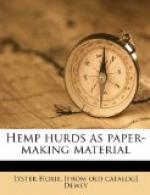In view of these conditions it is advisable to investigate the paper-making value of the more promising plant materials before a critical situation arises. To be of substantial value the investigations should include not only a determination of the quality and quantity of pulp and paper which the material is capable of producing, but should embrace a consideration of such relevant factors as agricultural conditions, farm practice, assembling conditions, transportation, and probable future supply.
Certain cultivated plants seem particularly promising, because in the harvesting of the regular crop that portion which might be utilized for paper manufacture necessarily is either wholly or partially assembled. To this class of plants belong corn, broom corn, sorghum, sugar cane, bagasse, flax, hemp, and the cereal straws.[1]
[Footnote 1: For descriptions of investigations of some of these crops, see the list of publications at the end of this bulletin.]
It is generally conceded that the employment of different raw materials would probably yield products of a somewhat different quality than those now prevailing in the markets, but the qualities of papers and the public demands are so diversified and numerous that this possible objection should not be serious. Ten years ago sulphite manufacturers would not accept consignments of spruce logs if they contained over 5 per cent of fir, while to-day many manufacturers tolerate 50 per cent. Rope papers are found to contain not only jute, but when this raw material is not plentiful, chemical pulp of various kinds. “Linen paper” is often no more than a trade term. Not long ago printing papers were made entirely from chemical wood pulp, but to-day if it is desired to secure paper which is free from ground wood the specifications must so stipulate. Writing papers, formerly made entirely from rags, now are likely to contain either chemical or even ground-wood pulp unless the specifications prohibit it. Without doubt, many paper manufacturers have maintained certain papers up to a fixed standard for a long series of years, but it is equally true that competition has lowered the standard of a great many papers, some of which had acquired a distinctive recognition. The employment of plant fibers will not necessarily lower the present quality of papers, but if their employment does result in products whose qualities are somewhat different from our so-called standard papers it does not necessarily follow that such papers will not find a ready market.
=Factors justifying an investigation of hemp hurds.=
Hemp hurds form a crop waste, in that they necessarily are produced in the raising and preparation of hemp fiber, and their present use and value are comparatively insignificant.




